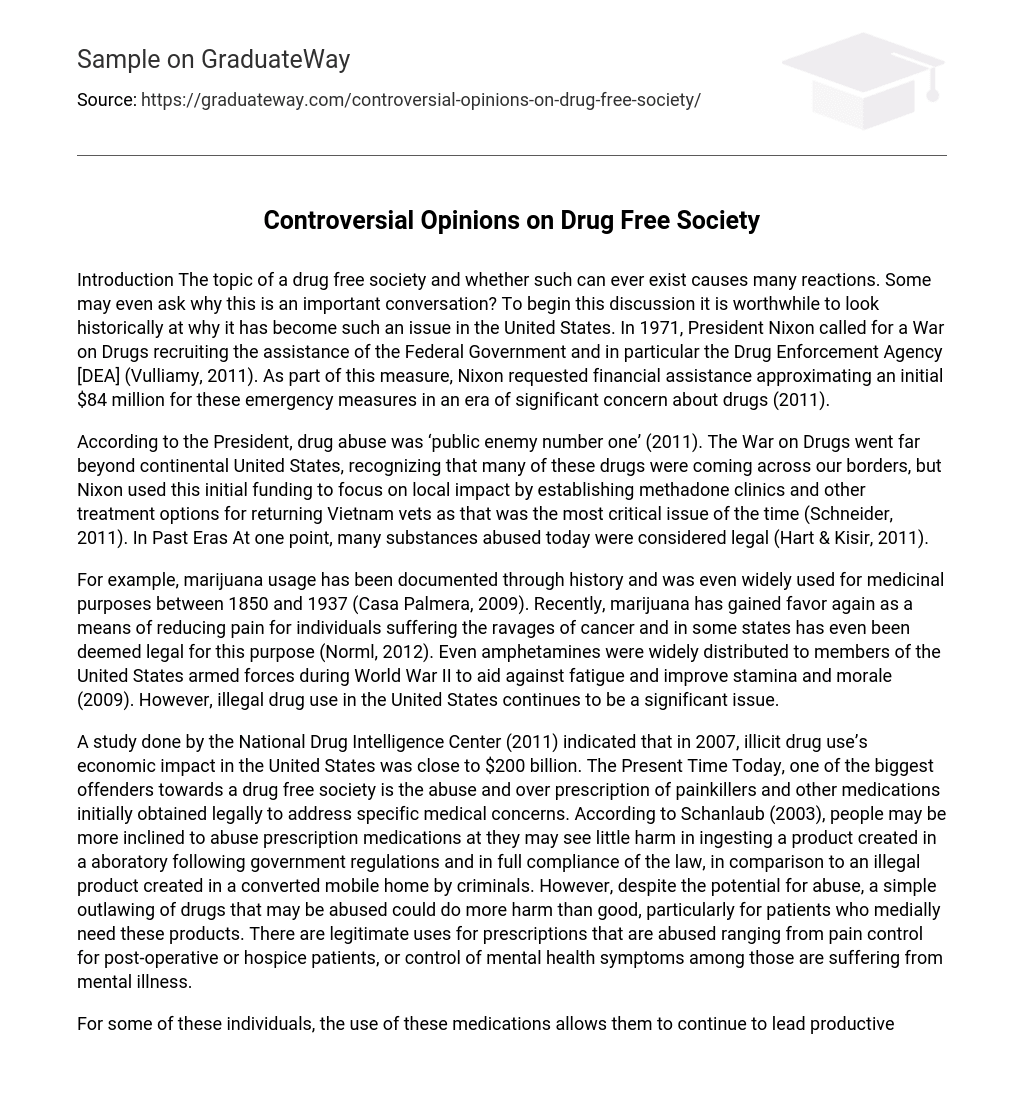Introduction The topic of a drug free society and whether such can ever exist causes many reactions. Some may even ask why this is an important conversation? To begin this discussion it is worthwhile to look historically at why it has become such an issue in the United States. In 1971, President Nixon called for a War on Drugs recruiting the assistance of the Federal Government and in particular the Drug Enforcement Agency [DEA] (Vulliamy, 2011). As part of this measure, Nixon requested financial assistance approximating an initial $84 million for these emergency measures in an era of significant concern about drugs (2011).
According to the President, drug abuse was ‘public enemy number one’ (2011). The War on Drugs went far beyond continental United States, recognizing that many of these drugs were coming across our borders, but Nixon used this initial funding to focus on local impact by establishing methadone clinics and other treatment options for returning Vietnam vets as that was the most critical issue of the time (Schneider, 2011). In Past Eras At one point, many substances abused today were considered legal (Hart & Kisir, 2011).
For example, marijuana usage has been documented through history and was even widely used for medicinal purposes between 1850 and 1937 (Casa Palmera, 2009). Recently, marijuana has gained favor again as a means of reducing pain for individuals suffering the ravages of cancer and in some states has even been deemed legal for this purpose (Norml, 2012). Even amphetamines were widely distributed to members of the United States armed forces during World War II to aid against fatigue and improve stamina and morale (2009). However, illegal drug use in the United States continues to be a significant issue.
A study done by the National Drug Intelligence Center (2011) indicated that in 2007, illicit drug use’s economic impact in the United States was close to $200 billion. The Present Time Today, one of the biggest offenders towards a drug free society is the abuse and over prescription of painkillers and other medications initially obtained legally to address specific medical concerns. According to Schanlaub (2003), people may be more inclined to abuse prescription medications at they may see little harm in ingesting a product created in a aboratory following government regulations and in full compliance of the law, in comparison to an illegal product created in a converted mobile home by criminals. However, despite the potential for abuse, a simple outlawing of drugs that may be abused could do more harm than good, particularly for patients who medially need these products. There are legitimate uses for prescriptions that are abused ranging from pain control for post-operative or hospice patients, or control of mental health symptoms among those are suffering from mental illness.
For some of these individuals, the use of these medications allows them to continue to lead productive lives. Even in the realm of substance abuse treatment, there are changing views as more substance abusers are presenting with co-existing mental illnesses (Perfas & Spross, 2007). Conclusion In conclusion, the author of this brief paper believes that a drug free society in purest terms will never exist. Further, there are many good uses of drugs that reduce harm rather than cause harm. Some even argue whether we should focus on free drugs rather than drug free.
The challenge remains as to how to focus the conversation on meaningful policy reform recognizing that for many the issue is addiction and the focus needs to be on screening, brief intervention and referral to treatment as an effort to “medicalize” the drug problem through early identification of addiction (Obama, 2012). ? References Casa Palmera. (2009). The history of illegal drugs in America. Retrieved from http://www. casapalmera. com/articles/the-history-of-illegal-drugs-in-america/ Hart, C. L. , & Ksir, C. (2011). Drugs, society, and human behavior. (14 ed. ). New York: McGraw-Hill.
National Drug Intelligence Center. (2011). The economic impact of illicit drug use on American society: 2011. Retrieved from U. S. Department of Justice website: http://www. justice. gov/archive/ndic/pubs44/44731/44731p. pdf Norml. (2012). Legal issues: Medical marijuana. Retrieved from http://norml. org/legal/medical- marijuana-2 Obama, B. (2012, May 1). Obama drug policy: Science over dogma, evidence over ideology. Retrieved from http://www. whitehouse. gov/ondcp/news-releases-remarks/remarks-by-director-kerlikowske-on-the-third-way-in-drug-control-policy-at-the-center-for-american Perfas, F. B. , & Spross, S. 2007). Why the concept-based therapeutic community can no longer be called drug-free. Journal Of Psychoactive Drugs, 39(1), 69-79. Schanlaub, R. (2003). A prescription for abuse. Law & Order, 51(11), 93-96. Retrieved from http://search. proquest. com/docview/197227919? accountid=36653 Schneider, E. (2011, November 2). The drug war revisted. Retrieved from http://www. berfrois. com/2011/11/eric-schneider-smack-demand/ Vulliamy, E. (2011). Nixon’s ‘war on drugs’ began 40 years ago, and the battle is still raging. The Observer, Retrieved from http://www. guardian. co. uk/society/2011/jul/24/war-on-drugs-40-years





